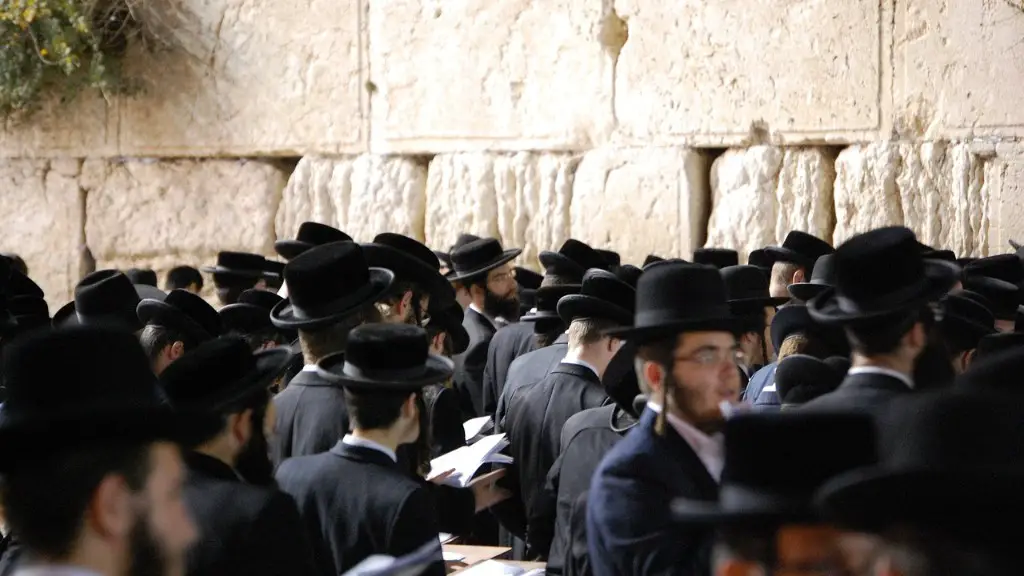The Hebrew Bible is one of the most important documents in the history of humankind and carries great significance for the Jewish faith. Known as the Tanakh in Hebrew and the Old Testament to Christians, it is the core sacred text of the Jewish religion, sometimes referred to as the ‘Holy Book of Judaism.’ It is composed of three major sections – Torah, Nevi’im, and Ketuvim – and dates back to as early as the 10th Century BCE.
The Torah is the first of the three sections and contains the Laws of Moses, known as the five books of Moses. Written by Moses himself, it is the foundation of Jewish law, ethics, and culture. It covers the creation of the world from Genesis to the last book of Deuteronomy and provides guidance for Jewish religious life. Along with this, it helps the Jewish people remember their long journey and the history of their people.
The other two sections are Nevi’im and Ketuvim. They are also known as ‘The Prophets’ and ‘The Writings’ respectively. Nevi’im contains prophetic messages from the time of Moses up to the time of the Great Assembly around 400 BCE. These prophetic messages are seen as a foretelling of the future and provide spiritual guidance. Lastly, Ketuvim contains a wide variety of writings, consisting of poetic and religious works, literature, and historical non-fiction. This section contains some of the best-known and most loved writings, such as The Song of Songs, and Psalms.
The Holy Book of Judaism is not only sacred to the Jewish people, but its influence can also be found in the religion of Christianity. Christians around the world use the terms ‘Old Testament’ and ‘New Testament,’ together referred to as the Bible. This collected work is split into two, with the Old Testament containing similar stories and teachings to that of the original Hebrew Bible, and the New Testament containing the teachings and preaching of Jesus of Nazareth.
The teaching, history, and prophetic messages found in the Tanakh are essential to passing on Jewish history and providing guidance in Jewish faith and practice. In fact, some traditional Jews still practice wearing phylacteries every day, a practice based on a verse in the book of Exodus, which binds select passages of the Torah to their skin. To the Jewish people, the Holy Book of Judaism is beyond words, with many seeing it as being a direct connection to their Creator and way to a more meaningful life.
The Importance Of The Torah
The Torah is of great importance to the Jewish people, often seen as the source of their faith and the foundation of their beliefs. It provides both spiritual and moral guidance and serves as a guide for understanding the relationship between God and humanity. The first five books of the Torah, or the books of Moses, are seen as the fundamental code of law for Jews and all extra-Torah laws are seen as a reflection or a commentary of the Torah.
The importance of the Torah is deeply emphasized in Judaism and is a central text in all forms of the faith. It is considered the Holy Book of Judaism and while not worshipped directly, it is venerated and respected. It is seen as the ultimate source of truth in Jewish faith and is often used in Jewish ceremonies and rituals. For example, Jews around the world still follow the ceremony of wrapping themselves in a Torah scroll and recite a blessing upon doing so.
In addition, the Torah is seen as a connection to the past. It is the source of Jewish identity and is read by every Jewish person, whether they be a secular or an ultra-Orthodox traditionalist. Its stories and teachings are used to pass on knowledge of Jewish history from generation to generation and are used to celebrate and honor the heritage of the Jewish people.
Modern Interpretations Of The Tanakh
The way in which the Tanakh is interpreted changes in time and with the differing cultures that differ in religious belief. Jews of all backgrounds, from the Reform Jews to the Ultra-Orthodox Hasidic Jews, draw from the Hebrew Bible in different ways and find different things from its pages. For instance, Reform Jews focus mainly on the moral teaching, while Ultra-Orthodox Jews study it as a historical document and strive to follow its laws.
In recent years, new interpretations of the tanakh are being developed by scholars. This has seen a rise in modern commentators who apply an interdisciplinary approach to the Hebrew Bible, which includes looking at the Bible through the lens of psychology, sociology, history, and other fields. Their interpretations provide insight into the text, giving new understanding and a different perspective in which it can be viewed from.
Modern interpretations are also affected by the fact that there are now multiple translations of Tanakh available. Some translations emphasize one aspect of the text more than another, while other translations attempt to be faithful to the original and leave out any analysis or interpretation by the translator.
The Authority Of The Tanakh
The authority of the Tanakh lies in its antiquity and its role as the core sacred text of the Jewish faith. It carries authority through its veneration and the fact that it is seen as being a direct communication from God. Torah study is a major part of Jewish life, with many believing it to be your way to understand and strengthen the relationship between God and humanity.
The authority of the Tanakh also lies in its role as a source of a wide range of knowledge. Its stories, moral teachings, and its historical accounts provide unique insights into the workings of the world, which can be related to the now. People of all religious beliefs can draw from the Tanakh, from understanding kindness and mercy, to understanding of justice, justice and the role of God in their lives.
The Tanakh also carries authority through its vastness. Its stories and teachings span thousands of years, and its collection of books contains an extensive amount of knowledge, all referred to by a single term, the ‘Holy Book of Judaism.’ Not only that, its message consists of a multitude of topics, from faith and love, to justice, reward and punishment
The Interpretation of the Tanakh
The way in which the Tanakh is interpreted is largely dependent on the background of the reader and the approach taken by them. Different forms of the faith and even different denominations within the same faith use different methods to interpret the text. For some, it is seen as a set of laws that people should try to move away from as much as possible, for others it is seen as a source of moral teachings, and for some, it is seen as a source of understanding of the world.
Within Judaism, different schools of thought lead to different interpretations of the text. Orthodox Jews view the Holy Book of Judaism as literal and see the text as the ultimate source of truth. They believe that the Tanakh contains a complete set of instructions for living a moral and religious life and strive to follow these instructions exactly. Progressive Jews tend to take a more flexible approach and apart from strictly following the laws, they often rely on modern philosophy to help interpret the teachings.
In addition, the text of the Tanakh is open to multiple interpretations, as is true of all sacred texts. As a result, there is often disagreement among the Jewish community as to what is meant by the text and which interpretation is correct. This disagreement is one of the most interesting aspects of reading Tanakh and provides an opportunity for dialogue and debate.
The Preservation Of The Tanakh
The preservation of the Tanakh, one of the most important documents in human history, is paramount to the Jewish people and is seen as one of the most important aspects of Jewish religious life. The Jewish people have taken great measures in order to preserve the original texts, from being meticulous about the details of the Torah Scrolls to taking steps to stop any accidental changes or corruption of the text.
In addition, the preservation of the Tanakh can be seen in the way in which Jewish traditions surrounding the text have been passed down from generation to generation. This can be seen in the way information is passed from one generation to the next and the emphasis that is placed on education and the learning of Jewish history.
Many Jewish people show their dedication to the preservation of the Tanakh by participating in formal study in Yeshivas, or religious schools, as well as learning through informal study at home. Furthermore, the dedication of rabbis around the world in teaching written, oral, and visual Torah is invaluable in helping to maintain the dignity of the Tanakh.
The Worth Of The Tanakh
The Tanakh is seen as being of tremendous worth to the Jewish people. For many, it is seen as containing the secret to a meaningful life, providing the source of wisdom and insight on how to go about living. Its stories and teachings are vaster than any other sacred book and its influence can be seen in other sacred texts and traditions.
The worth of the Tanakh lies in its rich history and its endless stories. Many of these stories provide a direct connection to the Jewish people’s past and to the God they worship. Additionally, its moral teaching and philosophical musings provide insight into the workings of the universe, whilst at the same time giving guidance on how to be a righteous and moral person.
Due to its value, the Tanakh is treated with immense respect. In traditional homes, it is kept in a special cabinet and is never put on the ground or subject to disrespect. Its words are used in rituals and ceremonies, and its stories are discussed in living rooms around the world. The Tanakh is seen as being of great worth to the Jewish people and to the history of humanity.

